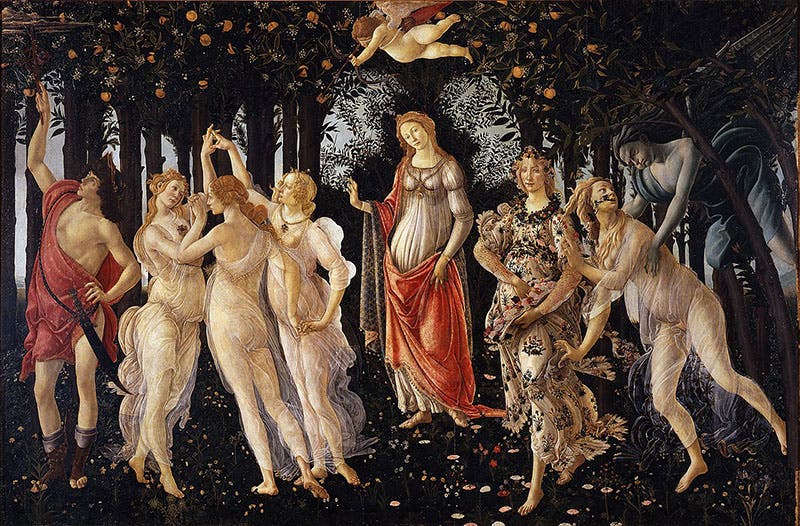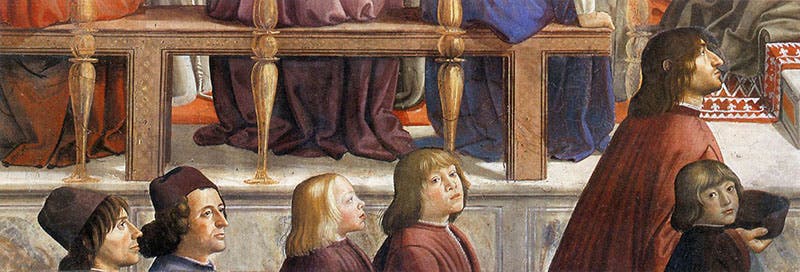Scientist of the Day - Angelo Poliziano
Angelo Poliziano, an Italian classical scholar and poet, was born July 14, 1454. Poliziano was one of the outstanding humanists of Renaissance Florence, which is a way of saying that he recovered classical texts, wrote commentaries and lectured upon them, and was inspired by his classical studies to compose his own literary pieces. He was an integral part of the Medici court of Lorenzo il Magnifico, saved Lorenzo’s life during the infamous Pazzi conspiracy of 1478, and was the tutor to Lorenzo's children. He did not have much to do with Renaissance science, but he did impact several well-known Florentine paintings, and since art often intrudes into these notices, these paintings provide an excuse for discussing Poliziano today.
Poliziano’s main contribution to Renaissance art was in providing much of the mythological substance for Sandro Botticelli's great painting, Primavera (ca 1482; second image, just above). Around 1480, Poliziano had produced a commentary on Ovid's Fasti, a poem about the Roman calendar, and Poliziano lectured on the Fasti at the University of Florence, known as the Studio. In the poem about the month of May, Ovid tells how the nymph Chloris was ravished by the west wind Zephyrus and transformed into Flora; these just happen to be the three figures to the right of Venus and Eros in Botticelli's painting. The Primavera now hangs in the Uffizi in Florence. Since Flora, Chloris, and Venus also appear in Botticelli’s other great work, The Birth of Venus, Poliziano might have had an influence of that painting as well.
Poliziano was also apparently on good terms with Domenico Ghirlandaio, another artist at Lorenzo's court. Ghirlandaio was commissioned by the Sassetti family of Florence to decorate the chapel they owned in Santa Maria Novella in Florence. Unfortunately, the Sassettis’ wanted a series of frescoes commemorating Francis of Assisi, and the officials of Santa Maria Novella, a Dominican church, were not at all keen on advertising their principal rival, the Franciscans. So the Sassettis sold the right to their first chapel and secured another, this time in Santa Trinita, a Franciscan church, which is where Ghirlandaio executed his paintings. One of the frescoes, Confirmation of the Franciscan Rule (1483-85), shows the Pope giving his approval to St. Francis’s new order (third image, just above). That is Lorenzo among the patrons at the right, with the black hair. But the foreground is all about the “Establishment of the Medici”. Coming up out the basement, near the lower frame, are Lorenzo’s two children and his young nephew, accompanied by an older man, their tutor (see detail, fourth image, just below). That tutor is Poliziano, and Ghirlandaio has given us one of the best portraits we have of the Medici court humanist. Interestingly, of the three children, Giovanni (the blond in the rear) would be elected Pope Leo X in 1513, and the nephew in the front, Giuliano, would be elected Pope Clement VII in 1523. How many other Renaissance paintings show two future Popes, I wonder?
The chapel that Sassetti sold, in Santa Maria Novella, was bought by the Tornabuoni family, and they subsequently commissioned Ghirlandaio to decorate it as well. One of his paintings is called Angel Appears to Zacharias, depicting the annunciation to the father of John the Baptist that his wife is to bear a son (fifth image, just below). Ghirlandaio chose to populate the foreground with living court figures, and I call your attention to a detail showing the grouping in the front left corner (sixth image, below). This is one of the great insets of Renaissance art, as it depicts four of the most distinguished humanists at the Medici Court. Marsilio Ficino, the first translator of Plato and founder of the Platonic Academy, is at far left. Next to him is Cristoforo Landino, who was the tutor for Lorenzo the Great when he was growing up. At the far right is Demetrios Chalkokondyles, a Greek humanist from Athens who published the first edition of Homer. And the fourth figure, the one facing us, is Poliziano, for the second time gracing an important Renaissance painting.
We can find a third portrait of Poliziano on a medal in the great Samiel H. Kress Collection of Renaissance medals in the National Gallery of Art in Washington, D.C. (first image).
Lorenzo de’ Medici died in 1492 and was succeeded by Piero “the Unfortunate”, the middle child in the Confirmation of the Rule, who was then expelled from Florence in 1494, along with the rest of the Medici family. Poliziano died that same year, of arsenic poisoning, shortly before his close friend and possible lover, Giovanni Pico della Mirandola, suffered the same fate. The poisoner is unknown, although many implicate Piero de’ Medici and others suspect the Borgia Pope, Alexander VI. Whatever precipitated the demise of these two great scholars, it was truly the end of a golden era in Renaissance Florence.
Dr. William B. Ashworth, Jr., Consultant for the History of Science, Linda Hall Library and Associate Professor emeritus, Department of History, University of Missouri-Kansas City. Comments or corrections are welcome; please direct to ashworthw@umkc.edu.









![Using an astrolabe to measure the depth of a well, woodcut in Elucidatio fabricae vsusq[ue] astrolabii, by Johannes Stöffler, 1513 (Linda Hall Library)](https://assets-us-01.kc-usercontent.com:443/9dd25524-761a-000d-d79f-86a5086d4774/a998eb50-55d2-4a88-ace2-a50aa5fa86e7/Stoffler%201.jpg?w=210&h=210&auto=format&fit=crop)

